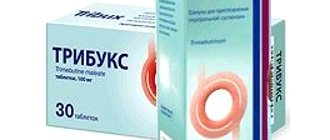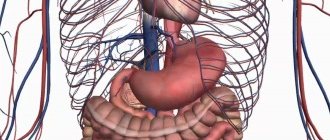- Composition
- Dosage form
- Basic physical and chemical properties:
- Pharmacological group
- Pharmacological properties
- Indications
- Contraindications
- Interaction with other drugs and other types of interactions
- Features of application
- Use during pregnancy or breastfeeding
- The ability to influence the reaction rate when driving vehicles or other mechanisms
- Directions for use and doses
- Children
- Overdose
- Adverse reactions
- Storage conditions
- Package
- Vacation category
Pharmacological properties of the drug Gastrocepin
Pirenzepine is a selective blocker of M1-cholinergic receptors of the parietal and main cells of the gastric mucosa, inhibits the production of hydrochloric acid and increases the pH of the stomach. In therapeutic doses it does not penetrate the BBB. Pharmacokinetics. Pirenzepine is not completely absorbed from the gastrointestinal tract. The maximum concentration in blood plasma is determined 2–3 hours after administration. After oral administration, the average bioavailability is 10–20%. Concomitant use with food reduces the AUC value by 30%. Only 12% of pirenzepine is bound to plasma proteins. It penetrates poorly through the placental barrier and the blood-brain barrier, and is excreted into breast milk in minimal quantities. After oral administration, it is almost completely excreted in feces; when administered parenterally, it is excreted equally in urine and feces. Total plasma clearance is about 250 ml/min. Renal clearance is about half this value, which is approximately equivalent to the level of glomerular filtration. The drug is characterized by a long half-life (10–12 hours), which explains its long-lasting therapeutic effect. The pharmacokinetics of the drug does not change significantly in case of renal or hepatic failure. The apparent volume of distribution averages 14 L, which corresponds to the approximate volume of the extracellular space in humans.
Gastrozepin instructions for use
Composition active ingredient: pirenzepine;
1 tablet contains Pirenzepine dihydrochloride 25 mg
excipients: lactose monohydrate, corn starch; silicon dioxide colloidal magnesium stearate.
Dosage form
Pills.
Basic physical and chemical properties:
round, white tablets, flat on both sides, with beveled edges on one side of the tablet - a break line and the marking “61C” on both sides of the break line, on the other side of the tablet - the company symbol.
Pharmacological group
Drugs for the treatment of peptic ulcers and gastroesophageal reflux disease. ATX code A02B X03.
Pharmacological properties
Pharmacological.
Pirenzepine selectively blocks muscarinic receptors, reduces gastric acid production and increases gastric pH. In therapeutic doses, it does not penetrate the blood-brain barrier.
Pharmacokinetics.
Pirenzepine is not completely absorbed in the digestive tract. The average absolute bioavailability is only 10-20%.
When taking 50 mg of Pirenzepine half an hour before meals, peak plasma concentrations of approximately 30-35 ng/ml are achieved after 1-3 hours.
When taking Pirenzepine half an hour before meals or during meals, the area under the plasma concentration-time curve (AUC) is reduced by up to 30% compared to using the drug after an overnight fast.
Pirenzepine is weakly bound to plasma proteins (approximately 12%).
The volume of distribution averages 14 L, corresponding to the approximate human extracellular space.
Diffusion across the blood-brain barrier and placenta is minimal; It has been found that only minimal amounts of the drug pass into breast milk.
Pirenzepine is excreted almost entirely unchanged in the feces. The total clearance is approximately 250 ml/min. Renal clearance is approximately half this value, approximately equivalent to the glomerular filtration rate.
The half-life of Pirenzepine is from 10 to 12:00. The pharmacokinetics of pirenzepine are not significantly affected by hepatic impairment and mild or moderate renal impairment.
Indications
Ulcer of the stomach and duodenum.
Contraindications
Established hypersensitivity to any of the components of the drug.
Severe renal failure (creatinine clearance <20 ml/min).
Paralytic intestinal obstruction. Patients with rare hereditary forms of galactose intolerance, lactase deficiency or glucose-galactose malabsorption syndrome (see section "Peculiarities of use").
Interaction with other drugs and other types of interactions
Stimulation of gastric secretions induced by certain foods and medications (eg alcohol, caffeine) may be suppressed.
The simultaneous use of the drug Gastrocepin and H2 receptor blockers leads to a more pronounced decrease in the secretion of gastric acid.
With simultaneous use of Pirenzepine with anti-inflammatory drugs, the sensitivity of the digestive tract to these drugs improves and the anti-inflammatory effect does not change.
Features of application
Pirenzepine should be used with caution in patients with:
- closed-angle glaucoma;
- prostatic hypertrophy and urinary retention
- tachycardia.
The use of gastrocepin may mask the symptoms of stomach cancer and thereby delay the correct diagnosis. Therefore, before starting treatment for a stomach ulcer, it is necessary to conduct appropriate examinations to identify malignant diseases.
Patients with duodenal or gastric ulcers should be tested for Helicobacter pylori (HP) infection. If the presence of HP infection is confirmed, eradication therapy should be carried out, since successful implementation of this therapy usually also leads to healing of the ulcer.
Gastrocepin tablets contain 833.64 mg of lactose in the maximum recommended daily dose, therefore patients with rare hereditary forms of galactose intolerance, lactase deficiency or glucose-galactose malabsorption syndrome should not use the drug (see section “Contraindications”).
In patients with severe renal impairment (creatine clearance <30 ml/min), attention should be paid to the development of adverse reactions and the dose should be reduced if necessary.
If anticholinergic adverse reactions, such as visual disturbances or urinary retention, occur, gastrocepin treatment should be discontinued.
Use during pregnancy or breastfeeding
Information on the use of Pirenzepine in pregnant women is limited.
It has been established that pirenzepine passes into breast milk in very small quantities. As a result, anticholinergic effects may be observed in the breastfed baby.
The use of the drug should be avoided during pregnancy and breastfeeding.
No studies have been conducted on the effect on fertility.
The ability to influence the reaction rate when driving vehicles or other mechanisms
Studies on the ability to influence reaction speed when driving vehicles or working with other mechanisms have not been conducted.
During treatment with gastrocepin, side effects may occur, such as impaired accommodation, so this drug is recommended to be used with caution when driving vehicles or other mechanisms.
If patients experience accommodation disturbances, they should avoid driving or operating machinery.
Directions for use and doses
Unless otherwise prescribed, use 50 to 150 mg per day in divided doses. It is usually recommended to take 50 mg 2 times a day in the morning and evening (2 tablets in the morning and 2 tablets in the evening). Sometimes during the first 2-3 days of treatment it may be necessary to take an additional dose during the day. The tablets should be taken approximately 30 minutes before meals with a small amount of liquid. In case of rapid subjective improvement in the patient's condition, the course of treatment prescribed by the doctor should not be reduced or interrupted.
The duration of use of the drug should be from 4 to 6 weeks.
Children
Currently, there is no evidence of the safety and effectiveness of the use of Pirenzepine dihydrochloride in children.
Overdose
Symptoms When using large doses of Pirenzepine, anticholinergic effects may develop: increased body temperature, dryness and redness of the skin, dry mouth, dilated pupils, delirium, tachycardia, intestinal obstruction, urinary retention, reflex myoclonic movements, choreoathetosis. Therapy.
Hemodialysis, hemoperfusion, peritoneal dialysis, and repeated doses of activated charcoal are not effective in removing anticholinergic agents.
In case of severe intoxication (for example, hyperthermia, severe cases of delirium or tachycardia), physostigmine can be used intravenously in small doses.
In case of acute glaucoma, you must immediately seek help from a specialist and begin treatment with miotic drops.
Adverse reactions
According to the frequency of manifestations of adverse reactions, they are classified as follows: very often (≥ 1/10); often (≥ 1/100 to <1/10); uncommon (≥ 1/1000 to <1/100); rare (≥ 1/10,000 to <1/1000); very rare (≤1/10,000) unknown (cannot be determined from available data).
| Classification by organ system | frequency |
| From the immune system | |
| anaphylactic reactions | unknown |
| hypersensitivity | unknown |
| From the nervous system | |
| headache | often |
| confusion | Very rarely |
| From the organs of vision | |
| disturbance of accommodation | often |
| cardiac disorders | |
| tachycardia | unknown |
| From the digestive system | |
| dry mouth | Often |
| constipation | often |
| diarrhea | often |
| From the skin and subcutaneous tissue | |
| rashes | often |
| From the urinary system | |
| urinary retention | infrequently |
Use of the drug Gastrocepin
tablets are prescribed orally at a dose of 50–150 mg/day in several doses. As a rule, 50 mg 2 times a day is recommended. Very rarely in the first 2-3 days of treatment there is a need to take an additional dose during the day. Take morning and evening 30 minutes before meals with a small amount of liquid. Continuous oral therapy must be carried out (even with rapid subjective improvement) for at least 4-6 weeks without reducing the dose of the drug. The injection solution is usually administered intramuscularly or intravenously, 2 ml (contents of 1 ampoule) at intervals of 12 hours. For the prevention and treatment of stress ulcers of the upper gastrointestinal tract, it is recommended to administer 2 ml of the solution 3 times a day at intervals 8 hours. For Zollinger-Ellison syndrome, the dose of the drug can be increased by 2 times; in especially severe cases, it is recommended to administer the contents of two ampoules (4 ml of solution 3 times a day). Parenteral administration of the drug for Zollinger-Ellison syndrome usually precedes surgery. Parenteral therapy with Gastrocepin should be carried out until clinical improvement (usually within 2-3 days), after which they switch to taking the oral form of the drug. Note. IV administration of the drug is carried out as a slow bolus (at least 3 minutes) or, preferably, by infusion (iv drip). For intravenous infusion, Gastrocepin injection solution can be diluted in isotonic sodium chloride solution, Ringer's solution, 5% levulose solution or 5% glucose solution.
Gastrocepin 25 mg tablets 50 pcs - Instructions
Release form, packaging and composition Gastrocepin
Tablets are white or beige, round, flat on both sides, with a beveled edge, with a score line on one side and the embossed designation “61C” on both sides of the score line; The company's logo is engraved on the other side of the tablet.
| 1 tab. | |
| pirenzepine dihydrochloride (monohydrate form) | 25 mg |
Excipients: lactose, corn starch, colloidal silicon dioxide (Aerosil 200), magnesium stearate.
Clinical and pharmacological group
M1-cholinergic receptor blocker with a predominant effect on gastric receptors.
Pharmacotherapeutic group
M-anticholinergic agent.
pharmachologic effect
Pirenzepine selectively blocks muscarinic receptors, reduces the formation of gastric juice and increases the pH in the stomach. In therapeutic doses, the drug does not penetrate the BBB.
Pharmacokinetics
Pirenzepine is not completely absorbed from the gastrointestinal tract. Cmax in plasma is observed 2-3 hours after taking the drug. The average absolute bioavailability when taken orally is only 10-20%.
Taking pirenzepine with food results in a 30% decrease in AUC.
Pirenzepine is only slightly bound to plasma proteins (about 12%). Pirenzepine almost does not penetrate the BBB and placental barriers. Only a minimal amount of the drug is found in the milk of a nursing woman. When taken orally, pirenzepine is excreted mainly in the feces, mainly unchanged. The total plasma clearance is about 250 ml/min. Renal clearance is approximately half this value, which corresponds to the glomerular filtration rate. Pirenzepine is excreted from the body with an average T1/2 of 10-12 hours. Neither hepatic nor renal failure has a significant effect on the pharmacokinetics of pirenzepine. The Vd of the main substance is about 14 l, which approximately corresponds to the volume of the extracellular space of a person.
Indications for the drug Gastrocepin
- acute ulcer of the stomach and duodenum;
- peptic ulcer of the stomach and duodenum.
Dosage regimen
The tablets should be taken approximately half an hour before meals with a small amount of liquid. Unless otherwise prescribed by your doctor, you should take the drug 50-150 mg/day, divided into several doses. The usual dosage regimen is 50 mg 2 times a day, morning and evening.
Sometimes in the first 2-3 days of treatment it may be necessary to prescribe an additional dose of the drug in the middle of the day. Despite the rapid subjective improvement, the patient should not reduce the dose of the drug or stop taking the drug unless recommended by a doctor.
Treatment should be continued for 4-6 weeks.
Side effect
After using the drug, the following side effects were observed: dry mouth, accommodation disturbances, tachycardia, constipation, diarrhea, urinary retention, headache. Cases of allergic reactions and anaphylactic shock have been reported.
Contraindications for use
- hypersensitivity to any of the components of the drug;
- paralytic ileus in a patient.
Patients with existing galactose intolerance (galactosemia, lactase deficiency or impaired absorption of glucose-galactose in the intestine) should not use this drug. The maximum recommended daily dose contains 833.64 mg of lactose.
Gastrocepin should be used with caution in patients with glaucoma, benign prostatic hyperplasia, and tachycardia.
Use during pregnancy and breastfeeding
The drug should be used by pregnant and lactating women only if the expected benefit outweighs any possible risk to the fetus or newborn.
special instructions
In patients with glaucoma, it is recommended to periodically measure intraocular pressure.
Impact on the ability to drive vehicles and operate machinery
Due to visual impairment and accommodation, the ability to drive a car and operate machinery may be impaired.
Overdose
Symptoms: To date, there is no data on cases of overdose in humans. However, when large doses of pirenzepine are taken orally, the following anticholinergic effects may develop: hot flashes, dryness and hyperemia of the skin; dry mouth; mydriasis; rave; tachycardia; intestinal obstruction; urinary retention; convulsive muscle twitching; chorea, athetosis.
Treatment: Experience in the treatment of pirenzepine overdose is limited. In cases of poisoning with large doses of the drug taken orally, treatment begins with general measures (for example, the administration of activated carbon, gastric lavage). Hemodialysis, blood transfusion, peritoneal dialysis and repeated administration of activated charcoal do not remove pirenzepine from the body. In cases of severe intoxication (with fever, delirium or severe tachycardia), physostigmine can be prescribed in a small dose IV. In the event of an acute attack of glaucoma, you should use drugs that have an m-cholinomimetic effect (pilocarpine in the form of eye drops) and immediately seek advice from a specialist.
Drug interactions
The simultaneous use of Gastrocepin and H2-histamine receptor blockers is accompanied by a more pronounced decrease in the secretion of hydrochloric acid in the stomach.
Gastrocepin, used in combination with anti-inflammatory drugs, does not reduce their anti-inflammatory effect and improves their tolerability.
Storage conditions for Gastrocepin
Store in a dry place, at a temperature not exceeding 25°C. Keep out of the reach of children.
Shelf life of Gastrocepin
Shelf life: 5 years. Do not use after the expiration date stated on the package.
Terms of sale
The drug is available with a prescription.
Special instructions for the use of the drug Gastrocepin
The drug should be prescribed with caution for glaucoma and prostatic hypertrophy. During pregnancy and breastfeeding. Preclinical studies did not reveal any side effects of the drug, but the safety of its use during pregnancy has not been established. During this period, it is necessary to adhere to the usual precautions regarding the use of medications, especially in the first trimester of pregnancy. The active substance Gastrocepin passes into breast milk and as a result, an anticholinergic effect can be detected in a breastfed baby. IV injections should always be administered slowly due to the risk of thrombophlebitis due to the 39.2% propylene glycol content; patients with unstable blood circulation due to high initial blood pressure levels require constant monitoring. Impaired accommodation during treatment with the drug may reduce the ability to drive vehicles and operate potentially dangerous mechanisms.
Overdose of the drug Gastrocepin, symptoms and treatment
Symptoms: To date, there have been no reports of human overdose. However, when the drug is administered in high doses, anticholinergic effects are possible - dryness and hyperemia of the skin, a feeling of dryness of the oral mucosa, mydriasis, delirium, tachycardia, intestinal obstruction, urinary retention, reflex myoclonic movements, choreoathetosis. Treatment: despite the fact that experience in the treatment of pirenzepine overdose is very limited, in case of intoxication, general measures should be taken aimed at eliminating the unabsorbed substance in the digestive tract (gastric lavage, activated charcoal). Hemodialysis, hemoperfusion, and peritoneal dialysis are ineffective. In case of significant overdose, manifested by serious intoxication (hyperthermia, severe delirium and tachycardia), intravenous administration of physostigmine in low doses is indicated. If an attack of glaucoma develops, it is necessary to prescribe miotic drugs and consult a specialist.





